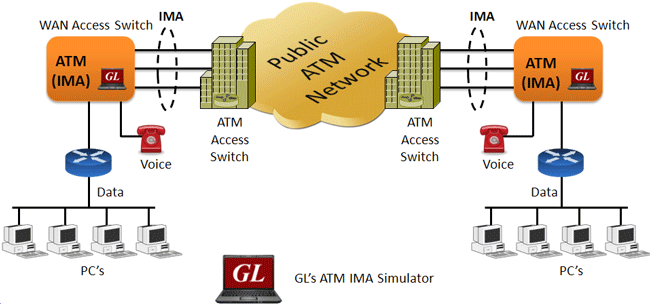Newsletter:GL Announces ATM IMA Emulator
Welcome to another January, 2012 issue of GL Communications' Newsletter providing information and insight into our latest product ATM IMA Emulator software.

Overview
Our Inverse Multiplexing over ATM (IMA) Emulator application can simulate inverse multiplexing of ATM cell streams over multiple physical links and retrieve the original stream at the far-end from these physical links. The multiplexing of ATM cell streams is performed on a cell-by-cell basis across the multiple physical links. Traffic source can be sequence number, HDL files (containing packets/frames), flat binary file, user-defined frames (ASCII HEX file), and Ethernet data.
The ATM Inverse Multiplexing technique involves inverse multiplexing and de-multiplexing of ATM cells in a cyclical fashion among links grouped to form a higher bandwidth logical link whose rate is approximately the sum of the link rates. This technique provides an effective method of combining the transport bandwidths of multiple links (e.g., DS1/E1 links) grouped to collectively provide higher intermediate rates. This is referred to as IMA grouping.
GL's IMA Emulator is available as an optional client-server based application with GL's T1 E1 Analysis hardware. GL also offers ATM analysis application for real-time capture and analysis of ATM IMA cells over multiple T1 E1 lines.
Simulating ATM Inverse Multiplex Groups and Links
The IMA Emulator allows grouping multiple link-layer channels into a single network-layer channel. An IMA group can consist of multiple physical links of the same type. Data sent through this channel will be distributed among all the links. It is a technique used to derive larger bandwidth pipe by aggregating smaller bandwidth pipes e.g. from multiple T1s or E1s. Each IMA group can be configured with IMA Frame Length (equal to 32, 64, 128 or 256) and Group Symmetry modes. Users are also allowed to create/delete Virtual Channels to generate/receive traffic on the created virtual channels.
Traffic Generation and Verification
The applications' GUI provides options to add virtual channels to IMA groups to perform traffic generation and verification. Tx parameters are used to generate the ATM traffic and Rx parameters are used as reference to verify the received frames. The results of the verification are displayed in Tx/Rx Verification tab. The parameters for each VC are independently set.
IMA Emulator as a Bridge
When the emulator is configured to act as bridge between two networks, all traffic received from the network is encapsulated into AAL5 cells and then are streamed over T1 E1 links. The Emulator on another network removes the ATM header, converts to Ethernet and streams to the destination.
Some of the Important Features:
- Performs IMA simulation on up to 16 T1 E1 ports
- ATM links can be created on full or fractional timeslots
- Supports hyper channels with discontinuous (sparse) timeslots
- IMA Frame Length can be set equal to 32, 64, 128, or 256
- Dynamically add/remove (Open/Close) of ATM links without loss in data
- Multiple IMA groups can be created with each group configured with multiple virtual channels for traffic tx/rx.
- Generate and verify end to end traffic on each Virtual Channel
- User configurable AAL5 packet size
- Payload traffic generation and verification using Sequence number, HDL file (containing packets/frames), Flat Binary file, and User defined frame (ASCII HEX file) for each Virtual Channel independently
- Transmit and receive Ethernet traffic over T1 E1 links by operating in bridge mode
For comprehensive information on the application, please visit ATM IMA Emulator web page.
 Back to Newsletter Index Page
Back to Newsletter Index Page